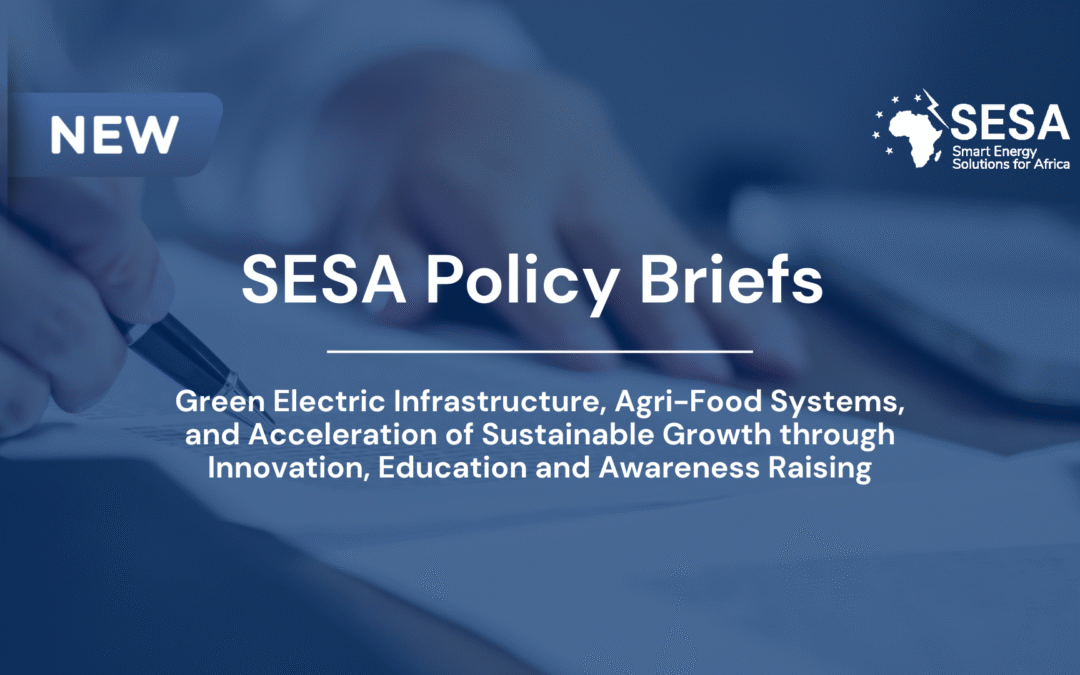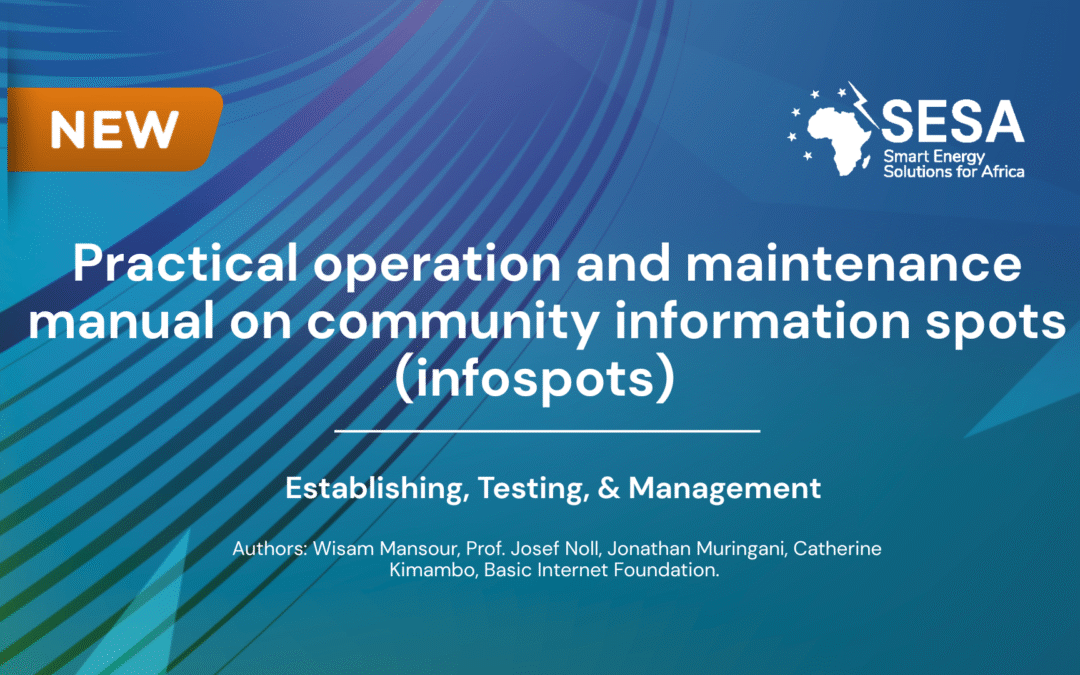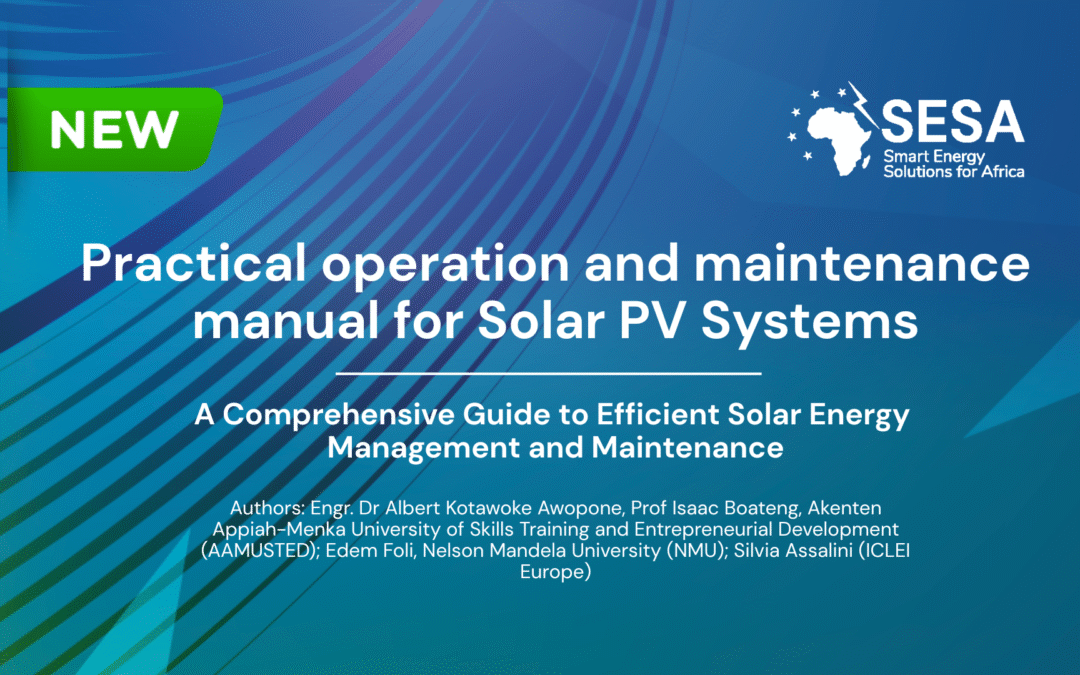Co-Designing a Web-Based Interface for an AI-IoT Hydroponics System with an Indigenous Community in Namibia
Co-Designing a Web-Based Interface for an AI-IoT Hydroponics System with an Indigenous Community in Namibia
Abstract

SESA Policy briefs on Green electric infrastructure, Agri-food systems, and Acceleration of sustainable growth through Innovation, Education and Awareness Raising
Despite Africa’s vast renewable energy potential – particularly in solar – more than 600 million people, or approximately 43% of the population in sub-Saharan Africa, still lack access to electricity (IEA, 2022). This enduring energy gap compels millions to rely on polluting and expensive fuels such as kerosene and biomass. These fuels not only strain household finances but also pose serious health risks and contribute significantly to environmental degradation (WHO, 2024)
The burden of energy poverty disproportionately affects women and girls, deepening gender inequalities by increasing unpaid domestic labour, reducing access to education, and limiting participation in income-generating activities (UN Women, 2021). Furthermore, at the current pace of electrification, coupled with rapid population growth, the number of people without access to electricity is projected to remain largely unchanged in the coming decades (IEA, 2022).
Despite this, Africa holds vast untapped potential to drive inclusive, clean energy-based development. Realising this potential requires equitable policy frameworks, community-driven innovation, and financing models that empower local actors. The AU-EU Innovation Agenda and the EU’s Global Gateway Africa–Europe Investment Package ,which aim to mobilise up to €150 billion in strategic investments, place innovation and energy access at the heart of the bi-regional partnership.
Realising Africa’s clean energy future demands more than infrastructure; it calls for inclusive innovation ecosystems, fit-for-purpose financing models, and targeted support for small and medium-sized enterprises (SMEs). It is within this context that a new generation of business models is emerging – designed to overcome affordability barriers, strengthen local ownership, and scale decentralised energy access.
This policy brief shares key insights emerging from the EU funded project Smart Energy Solutions for Africa (SESA). Drawing on lessons from technology demonstrations in Living Labs in Kenya, Ghana, Malawi, Morocco, and South Africa, as well as in replication countries Rwanda, Tanzania, Nigeria, and Namibia, this brief identifies key policy challenges and opportunities relevant to future EU development cooperation. It explores four key dimensions relevant for Africa’s energy transition: 1) Green Electric Infrastructure, 2) Agri-food Systems, 3) Acceleration of Sustainable Growth, and 4) Improving Education and Awareness Raising. These findings are intended to inform the work of the EU under its Global Gateway strategy, particularly in ensuring energy investments are both inclusive and transformative.
By centring innovation, community ownership, and financial inclusion, these efforts align closely with the United Nations 2030 Agenda for Sustainable Development, the African Union’s Agenda 2063, as well as with the ambition of the AU-EU Innovation Agenda to co-develop solutions that address shared challenges. However, barriers such as limited consumer awareness, constrained access to finance, and underdeveloped supply chains continue to impede broader adoption and scale-up.
Finally, no policy or technology can succeed without the engagement of local communities and the leadership of local authorities. A just and inclusive energy transition depends on trust, participatory design, and local ownership. These are not secondary to infrastructure; they are fundamental to impact and scale.
Outlined below are the most relevant policy insights from the SESA project, intended to inform the work of the EU under its Global Gateway strategy.
Policy suggestions that support the EU’s Global Gateway strategy
- Strengthen regulatory frameworks to accelerate the adoption of decentralised energy technologies and to address installation and maintenance services
- Establish robust quality standards in line with international norms
- Harmonise Extended Producer Responsibility (EPR) policy
- Domesticize manufacturing and local supply chains
- Regulate import-export practices
- Incentivize standardisation and quality assurance
- Tailor economic support mechanisms
- Develop and improve battery recycling and e-waste infrastructure
- Institutionalize coordination around clean cooking
- Deliver targeted trainings and capacity building at all levels
- Encourage public awareness through promotional campaigns
- Seek out the involvement of women and vulnerable groups to accelerate the adoption of clean energy solutions

New publication: Practical operation and maintenance manual on community information spots (infospots)
In many communities, accessing reliable internet can be a challenge. Lack of infrastructure, high costs, and limited knowledge can create a significant digital divide. But what if there was a way to provide essential online resources that are both accessible and affordable?
The answer lies in Community Information Spots, or InfoSpots, and a new manual designed to help communities, operators, and users get the most out of them.
Introducing the PRACTICAL OPERATION AND MAINTENANCE MANUAL ON COMMUNITY INFORMATION SPOTS (INFOSPOTS). Developed by the SESA project (Smart Energy Solutions for Africa) – Authors: Wisam Mansour, Prof. Josef Noll, Jonathan Muringani, Catherine Kimambo, Basic Internet Foundation and funded by the European Union, this guide is your key to unlocking the power of local connectivity
What Exactly Is an InfoSpot?
An InfoSpot is a localized internet access point that provides essential information where traditional internet is weak or too expensive. It’s a clever combination of technology: a powerful antenna that captures weak mobile signals, a Local Network Control Centre that manages Wi-Fi, and a local server that hosts free, cached content. This smart setup ensures communities can access vital information without incurring high data costs.
Why This Manual Is a Must-Have
This manual is more than just a guide—it’s a tool for empowerment. It provides the knowledge and skills necessary to ensure these critical systems are operated sustainably and effectively.
-
Empower Your Community: Learn how to install, test, and manage your local InfoSpot to provide reliable internet access to schools, small businesses, and community members.
-
Save Money & Resources: The manual teaches you best practices for operation and maintenance, helping you reduce unnecessary expenses on repairs and energy waste.
-
Promote Local Development: By providing consistent and reliable internet access, you can help your community bridge the digital divide, access new opportunities, and promote local growth.
-
Gain Practical Skills: Get detailed guidance on troubleshooting common issues and a security-focused approach to system management.
The manual also explains the “Internet Lite for All” concept, which uses a clever freemium model to balance inclusivity with sustainability. It provides free access to essential text-based information while offering premium access for bandwidth-intensive activities. This ensures everyone can access critical resources, regardless of their ability to pay.
This guide serves as an essential resource for system operators, community leaders, and everyday users. By empowering you with the knowledge to maintain your InfoSpot, we can ensure communities everywhere have the tools they need to thrive in a connected world.

New publication: Practical operation and maintenance manual for Solar PV Systems
Are you a technician, a small or medium-sized enterprise (SME) proprietor, or an ordinary consumer looking to master the operation and maintenance of your solar photovoltaic (PV) systems? Look no further!
Introducing the Practical operation and and Maintenance manual for Solar PV: A Comprehensive Guide to Efficient Solar Energy Management and Maintenance, a new publication from the SESA project (Smart Energy Solution for Africa) – Authors: Engr. Dr Albert Kotawoke Awopone, Prof Isaac Boateng, Akenten Appiah-Menka University of Skills Training and Entrepreneurial Development (AAMUSTED); Edem Foli, Nelson Mandela University (NMU); Silvia Assalini (ICLEI Europe).
This capacity-building manual is your go-to resource for optimising the efficiency, safety, and longevity of your solar PV systems.
What You’ll Gain from This Manual:
- Valuable Insights for SMEs: Learn the necessary knowledge and skills to optimise energy efficiency, regulate costs, and ensure the longevity of your solar PV systems.
- Comprehensive Maintenance Guidance: Get extensive, step-by-step instructions on routine maintenance, troubleshooting common issues, and knowing when to call for expert help.
- Empowerment for All Users: Whether you’re a homeowner or a small business proprietor, this manual will deepen your understanding of your solar PV system’s fundamental operation, performance monitoring, and environmental benefits.
- Safety First: The manual highlights essential safety protocols to protect individuals interacting with the systems and to prevent accidents.
Key Advantages:
- Cost Savings: Educate yourself on optimal strategies to operate and maintain your system, which helps eliminate unnecessary expenditures on repairs and wasted energy.
- Sustainable Practices: By promoting a deeper understanding of solar PV systems, the manual supports the overarching goal of reducing carbon footprints and advancing green energy solutions.
- Adherence to Standards: The guide assists users in adhering to both domestic and international benchmarks, ensuring your system is up to par.
- A Practical Resource: This is an indispensable guide for anyone involved in solar PV systems, offering practical, efficient, and security-focused advice.
Empower yourself and embrace sustainable energy with this essential new guide.



Recent Comments